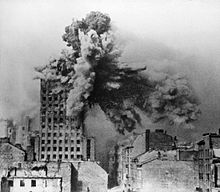Prudential, Warsaw
| Prudential House | |
|---|---|
 Prudential building view from Warsaw Uprising Square | |
 | |
| General information | |
| Architectural style | Art Deco |
| Town or city | Warsaw |
| Country | Poland |
| Construction started | 1931 |
| Completed | 1933 |
| Client | Prudential plc |
| Height | 66 m (217 ft) |
| Design and construction | |
| Architect | Marcin Weinfeld, Stefan Bryła, Wenczesław Poniż |
Prudential House,[1] commonly known as the Prudential is a notable skyscraper in Warsaw, Poland. Built between 1931 and 1933 in the Art Deco style, it served as a base for the British Prudential Insurance Company. It is located on Warsaw Uprising Square along Świętokrzyska Street. The Prudential was the tallest building in the interwar Poland.
History[]

At the time of construction it was the sixth tallest European skyscraper (after Telefónica Building, Boerentoren, Ullsteinhaus, Siemensturm & Bel-Air-Turm) with eighteen stories (66 m). Built using a steel framework it was the tallest building in Warsaw until the Palace of Culture and Science was constructed. The building, designed by Marcin Weinfeld, included office space on lower stories and luxurious apartments further up. The steel framework, innovative at the time, was designed by Stefan Bryła and Wenczesław Poniż. Construction started in 1931 and used up over 2 million bricks, 2 thousand tonnes of concrete and 1500 tonnes of steel.
In 1936 a 27 meter antenna was constructed on the roof by professor Janusz Groszkowski, who started the first television broadcasts in Europe from that facility. The Prudential building soon became a symbol of modern Warsaw and was featured in numerous contemporary films and advertisements.
The Prudential was heavily damaged during World War II, particularly during the Warsaw Uprising when it was hit by approximately 1,000 artillery shells, including a single hit by 2-tonne Karl-Gerät mortar shell, leaving only the steel framework. The artillery damage bent the construction sideways, but it survived the war and was featured on numerous anti-war posters.[2]
The building was rebuilt after the war as a hotel, and its style was changed from early modern to socialist realism. The author of the new design was again Marcin Weinfeld, who adapted the building to its new role as a hotel. The "Hotel Warszawa" was opened in 1954 and included 375 rooms, a large restaurant, a café and a night club.[3]
In 2002 the hotel closed and the building sold. In 2010, it was purchased by the Likus Group, which began a slow and controversial refurbishment. The façade was returned to its pre-war art deco form, while the socialist-realist interior was completely refurbished in a contemporary style.
In November 2018, the building re-opened as a 142-room luxury five-star Hotel Warszawa.[4]
See also[]
External links[]
| Wikimedia Commons has media related to Prudential building in Warsaw. |
Coordinates: 52°14′8″N 21°0′46″E / 52.23556°N 21.01278°E
References[]
- ^ Weinfeld, Marcin (1934). "Gmach Towarzystw Ubezpieczeń „Prudential" i „Przezorność" („Prudential House") w Warszawie". Architektura i Budownictwo (in Polish). 9: 267–287.
- ^ "One Photo One Story: The Skyscraper that Became the Symbol of the Warsaw Uprising". Retrieved 2019-05-29.
- ^ "Prudential, historia jednego budynku". Retrieved 2019-05-30.
- ^ "Capital's historic Prudential tower, embodying everything glamorous about interwar Poland, reopens as luxury hotel". Retrieved 2019-05-30.
- Buildings and structures in Warsaw
- Art Deco architecture in Poland
- Art Deco skyscrapers
- Buildings and structures completed in 1931
- Commercial buildings completed in 1933
- Prudential plc
